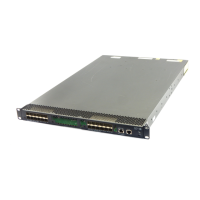396
If no global router ID is configured, the highest loopback address, if any, is used as the router ID. If no
loopback address is available, the highest physical interface IP address is used, regardless of the
interface status. If no IP address is configured for any interface, the router ID is 0.0.0.0.
During an active/standby switchover, the standby main processing unit (MPU) checks whether the
previous router ID that is backed up before switchover is valid. If not, it selects a new router ID.
If the interface IP address that is selected as the router ID is removed or modified, a new router ID is
selected. Other events, (the interface goes down; after a physical interface address is selected as the
router ID, an IP address is configured for a loopback interface; a higher interface IP address is
configured) will not trigger a router ID re-selection.
After a router ID is changed, use the reset command to make it effective.
Examples
# C on f i gu r e a g l o b a l r ou t e r I D a s 1.1.1.1.
<Sysname> system-view
[Sysname] router id 1.1.1.1
Related commands
router-id
router-id (BGP view)
Use router-id to configure a router ID for BGP.
Use undo router-id to remove the router ID for BGP.
Syntax
router-id router-id
undo router-id
Default
BGP uses the global router ID configured by router id in system view.
Views
BGP view
Predefined user roles
network-admin
Parameters
router-id: Specifies a router ID for BGP, in IP address format.
Usage guidelines
To run BGP, a router must have a router ID, which is an unsigned 32-bit integer that uniquely identifies the
router in the AS.
To modify a non-zero router ID for BGP, execute the router-id command in BGP view.
To improve availability, specify the IP address of a loopback interface as the router ID for BGP.
If you execute this command in the same BGP view multiple times, the most recent configuration takes
effect.

